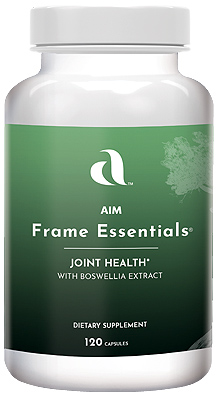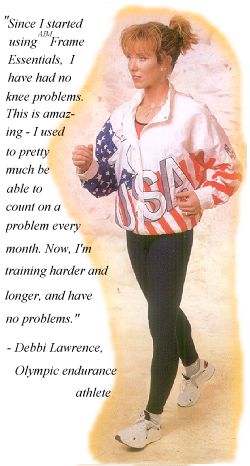|
AIM FRAME
ESSENTIALS ™
glucosamine sulfate, glucosamine HCL
MSM and boswellin extract
Benefits
-
Maintains musculoskeletal health
-
Provides building blocks for healthy joints
-
Improves joint function
-
Reduces pain
Features
-
Combines glucosamine sulfate and glucosamine HCL
- Includes MSM and boswellin extract
- 120-count tablets
The skeleton, made up of all the body’s bones, provides
strength, stability, and a frame for muscles to work within to produce
movement. Bones come together to form joints, most of which are in
constant motion. The ends of bones are covered with cartilage, a smooth,
tough, protective tissue that acts as a shock absorber and reduces
friction. The skin acts as a protective barrier to the outside world. Skin
also helps to regulate body temperature, senses painful and pleasant
stimuli, and shields us from the sun’s harmful effects.
Today, we are seeing increasing incidences of problems
with the musculoskeletal system. We can help ourselves maintain our
"body frame" health through nutrition and supplements. One of
the most powerful musculoskeletal supplements is
glucosamine.
Glucosamine
Glucosamine is an aminosugar. It is made in the body from
the simple carbohydrate glucose (sugar) and the amino acid glutamine.
Although our bodies generally use glucose to produce energy, the
aminosugars found in glucosamine are incorporated into the structure of
body tissue. Glucosamine is involved in the formation of cartilage, nails,
tendons, skin, eyes, bones, ligaments, and heart valves. It also plays a
role in the mucous secretions of the digestive, respiratory, and urinary
tracts. Of particular interest is its role in cartilage.
Cartilage
Cartilage is connective tissue at the ends of bones
(where it is known as articular cartilage). It separates bones so that
they do not grind together, causing stiffness and pain. Cartilage also
serves as a shock absorber. Briefly put, cartilage protects our bones from
the wear and tear of movement.
One way to think of cartilage is as a super sponge. It
soaks up water (more accurately, synovial fluid) when a joint is at rest,
and squeezes out the water when a joint moves. As the joint rests again,
it again soaks up water. This spongelike effect of cartilage makes it a
shock absorber, buffering our bones and body from the wear and tear of
making thousands of movements per day. Cartilage is also slippery—five to
eight times more slippery than ice. Thus, when two bones do meet, the
cartilage at the ends of each bone allows them to slide off each other,
adding to the buffering effect.
The cartilage matrix
Cartilage is made up of three main components: Water (70
to 80 percent), collagen (10 to 15 percent), and proteoglycans (10 to 15
percent). Combined, these are called the cartilage matrix. The cartilage
matrix is where new cartilage is born.
As we have seen, water provides cartilage with buffering
qualities, and also helps shape the "cartilage" sponge. It also
feeds the cartilage. Cartilage contains no blood vessels, so the soaking
up and squeezing out of water is what provides cartilage with
nutrients.
Collagen also plays a role in giving cartilage its shape
and resiliency, and it also absorbs shock. Think of collagen as super
strong threads that create the framework to hold the third component of
cartilage: proteoglycans.
Proteoglycans are large water-soluble molecules. They are
woven in among the collagen threads, forming a kind of netting. This
netting traps the water. Proteoglycans also act like magnets. The
individual molecules push away from each other, again allowing for space
and a buffering effect.
Finally, tiny factories called chondrocytes are located
throughout this netting. They produce new collagen and proteoglycans, as
well as enzymes that dispose of older, past-their-prime collagen and
proteoglycans.
The role of Glucosamine
Glucosamine stimulates chondrocytes to produce more
collagen and proteoglycans. The more glucosamine there is, the more
collagen and proteoglycans there are, and the more water can be absorbed.
The end result is healthier cartilage. Because of these properties,
glucosamine can help the body help itself repair damaged or eroded
cartilage. It works at the cellular level to reinforce our natural
"repair" ability.
When things go wrong
As we age, the millions of movements we have made in our
lives begin to wear and tear on cartilage. Catilage begins to deteriorate,
and our bones begin to rub together. This becomes noticeable around age
45, and often happens in the fingers, knees, hips, neck, and lower back.
Cartilage can also be destroyed through trauma, injury, and repetitive
actions.
When cartilage is damaged, the chondrocytes go into high
gear, manufacturing more proteoglycans and collagen. Unfortunately, these
replacements may be of inferior quality, or be overproduced, resulting in
bumpy joint surfaces. Chondrocytes also produce more of the enyzmes that
"eat away" old matter. These enzymes may begin attacking the
new, inferior cartilage, with an end result of diminished cartilage, not
more cartilage. This also may result in fewer proteoglycans, which means
the cartilage cannot hold water well. The cartilage can then dry out and
wear out more quickly.
The result is that we begin to feel our bones rubbing
together during movement. We experience pain and stiffness.
What to do
One way to counter the deterioration and destruction of
cartilage is to increase the amount of glucosamine your body has—remember,
glucosamine helps the body build and repair damaged cartilage. Glucosamine
is not only a "builder" but also a painkiller. In sum, it
improves joint function and reduces pain. It makes no difference whether
it comes from foods we eat or from supplements.
Proof positive
Many clinical trials have demonstrated that glucosamine
results in less pain due to cartilage deterioration and a wider range of
movement.
The first studies were performed in the 1960s, using
injectable forms of glucosamine sulfate. When glucosamine sulfate became
available in pill form, research switched to this.
Up to the present, most glucosamine studies have been
performed outside of North America. In all of these studies, glucosamine
sulfate proves to maintain joint health.
-
An early study in Italy found that 20 percent of those
using glucosamine sulfate became "symptom-free." Nearly 25
percent had no restriction of active or passive movement. The
researchers concluded that glucosamine sulfate rebuilt damaged
cartilage. Clinical Therapeutics 3, no. 4 (1980): 226-272.
-
A large-scale study looked at over 1,200 patients with
osteoarthritis. Results show that pain decreased throughout the trial,
that both active and passive movement improved, and that glucosamine
proved to work for six to 12 weeks after treatment had stopped.
Pharmatherapeutica 3, no. 3 (1982): 157-168.
-
In a study comparing glucosamine sulfate to the pain
reliever ibuprofen, the ibuprofen proved more effective the first two
weeks, but then faded. After eight weeks, the glucosamine sulfate group
reported better results. Current Medical Research and Opinioin 8, no.
3 (1982): 145-149.
-
More recently, Italian researchers found glucosamine to
be more effective than placebos or traditional NSAIDs (nonsteroidal
anti-inflammatory drugs) in treating osteoarthritis. Osteoarthritis
and Cartliage 5, supplement A (1997): 82.
It should be noted that although there are positive
results in all of these studies, not all participants experience them.
Thus, although glucosamine works for many people, it does not necessarily
work for all people.
AIM Frame
Essentials ™
AIM Frame
Essentials ™
contains two types of glucosamine—glucosamine sulfate and glucosamine
hydrochloride (HCL)—with methylsulfonylmethane (MSM) and boswellin
extract. This unique formula provides you with an all-around product to
maintain healthy joints and promote ease of movement.
Glucosamine
Both glucosamine sulfate and glucosamine HCL are forms of
glucosamine. Glucosamine makes up 63 percent of glucosamine sulfate and 83
percent of glucosamine HCL. Most human studies have used glucosamine
sulfate. This is because the company that paid for the research developed
this form. Glucosamine HCL has not been evaluated as extensively, but
clinical experience from a variety of health practitioners indicates that
glucosamine HCL works just as well. Many health practitioners recommend
trying one, and if that does not work, trying the other. AIMFrame
Essentials™
gives you both of these at once.
MSM
MSM is a biologically active form of the mineral sulfur.
Sulfur is the fourth most plentiful mineral in the body and is found in
every cell of the body. Sulfur plays a particularly important role in
tissue structure. MSM is naturally present in foods and the human body.
MSM has been used by veterinarians for more than 15 years, and use by
humans goes back some 20 years.
The formation of MSM begins when marine algae release
sulfur compounds that are transformed in ocean water into a substance
known as dimethyl sulfide (DMS). DMS rises into the atmosphere where it is
transformed into DMSO (dimethyl sulfoxide) and MSM. These compounds are
returned by rainwater to the earth, where they are absorbed by plants.
MSM contributes to healthy joints because, as a form of
sulfur, it adds to the benefits of glucosamine. It may aid glucosamine in
its role in maintaining healthy cartilage as well as in helping to
maintain joint flexibility and mobility. Many glucosamine users experience
increased benefits when adding MSM to their supplement
regimen.
Boswellin Extract
Boswellia serrata (Indian frankincense) has been used for centuries in the Indian
Ayurvedic system of medicine to maintain healthy joints. This is still one
of its main uses.
Boswellic acids improve blood supply to the joints and
maintain the integrity of blood vessels. At least one study has indicated
that they may open up collateral blood circulation to provide adequate
blood supply to the joints.
Boswellic acids have been known to reduce joint swelling,
maintain blood supply to inflamed joints, maintain mobility, and reduce
pain due to stiffness in the joints. They also have no side effects.
How to Use Frame Essentials
-
For optimal benefits, take 2 tablets in the morning and
2 tablets in the evening, for a total of 4 tablets per day. Best taken
with meals. After experiencing the desired results, take 1 tablet in the
morning and 1 tablet in the evening for maintenance.
-
Shelf life is 2 years, sealed. Close tightly after
opening and store in a cool, dry, dark place (70-75 °F; 20.1-23.8 °C).
Do not refrigerate.
Q & A
May children and pregnant women take Frame Essentials ?
There should be no reason for children to be using this
product. Pregnant women should consult with a health practitioner.
What is the source of the glucosamine in AIM Frame
Essentials ™?
The source of the glucosamine is marine shellfish.
May I take AIM Frame
Essentials ™ with other AIM products?
Yes, you may. You may experience positive synergy between
AIMFrame
Essentials™
and other AIM products.
May I take AIM Frame
Essentials ™ with other medications?
There are no indications that
glucosamine interacts with other medications. Of course, you should always
consult a health practitioner when adding new substances to your
regimen.
Is glucosamine actually absorbed?
Yes, in one study on glucosamine sulfate in pill form, 90
percent of the glucosamine was absorbed.
How does glucosamine compare to products such as Tylenol® and ibuprofen?
There is no doubt that products such as these provide
rapid relief. However, studies have shown that after four weeks of use,
glucosamine is as effective or more effective than these products in
providing relief from joint problems.
Does AIM Frame
Essentials ™ have any side effects?
Glucosamine is safe. A few people have reported stomach
upset and nausea. In a year of formal testing of glucosamine, no
significant side effects were found.
Suggested Reading
Mindell, Earl. The MSM
Miracle. New Canaan, CT: Keats Publishing, Inc., 1997.
This bulletin is for information only. It has not been evaluated by the U.S. Food and Drug Administration.
"This product is not intended to diagnose, treat, cure, or prevent any disease. Results may vary per person".
| 
